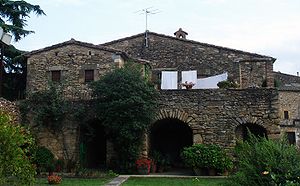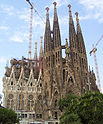- Masia
-
 A masia in Girona, Spain.
A masia in Girona, Spain.
A masia (Catalan pronunciation: [məˈzi.ə], Aragonese: pardina, Spanish: masía), more commonly known as mas in Catalan (pronounced [ˈmas]), is a type of rural construction common to the Iberian Peninsula, particularly during the ancient Kingdom of Aragon[1] which have their origins in the Roman villas. They are often large but isolated structures, nearly always associated with a family farming or livestock operation.
Through the ages, the materials utilised to construct masias varied, often determined by their location. In mountain areas, rough stone was often used, except for doorways, windows and arches, where stone was worked. During the middle ages, mud was used as mortar, though later on it was replaced by quicklime or cement. In places where stone was hard to come by, adobe was more common as a construction material.
For the most part, masias are oriented to face the south. Constructions older than 16th century have an arched main entrance while those built after the 18th century usually have lintel entrances. Masias were rarely more than 5 meters tall and were typically constructed with wooden beams placed perpendicular to the facade and covered by tiles. In the Pyrenees and other mountainous areas, the roofing would often be made of slate slate.
They tended to be at least two story buildings, with the ground floor reserved for farming tasks and even housing livestock, with the upper floor reserved for the family's living quarters. If there was a floor above that, it would often be used as a granary, or occasionally to house pigeons.
Many masias have been converted into bed and breakfasts or centers for rural tourism.
Contents
Images
-
The Masia Can Taxonera in Arenys de Mar
-
The Rectory of Premià de Dalt, from around the 17th Century.
-
Can Mora, in Sant Vicenç de Montalt
-
The Mas Can Masdeu, in Collserola on the outskirts of Barcelona
Notes
- ^ 1. f. An estate, with a finca of either agricultural or pastoral lands, typical of those in the ancient Kingdom of Aragon.
References
- Various authors; Gran enciclopèdia catalana, Ed. Enciclopèdia catalana, Barcelona, ISBN 84-85194-81-0
- Soldevila, Ferran et alt; Història de Catalunya, Selecta-Catalònia, Barcelona, 1989 ISBN 84-7667-045-1
See also
- Farmhouse
- Baserri
Architecture of Spain Styles Megalithic • Gallaeci • Iberian • Celtiberian • Roman • Visigothic • Asturian • Al Andalusian (Emirate and Caliphate, Taifa, Almohad and Nasrid) • Mozarabic • Repoblación • Mudéjar • First Romanesque • Romanesque • Gothic • Levantino Gothic • Catalan Gothic • Isabelline Gothic • Cisneros • Plateresque • Renaissance • Purism • Herrerian • Colonial • Baroque • Neoclassical • Modernisme • Neo-Mudéjar • National catholicism
Buildings and structures Roman sites • Castles • Cathedrals • Castros • Hórreos • Royal sites • Llotjas • Windmills • Lighthouses • Airports • Football stadiums • Museums • Tallest buildings and structuresOther Aragonese Mudéjar • Masía • Baserri • Pazo • Cabaña pasiega • Palloza • Andalusian White Towns • Andalusian Patio • ArchitectsCategory Categories:- Housing in Spain
-
Wikimedia Foundation. 2010.








